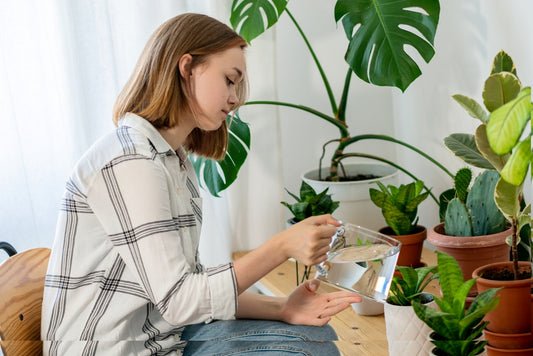Houseplants are a delightful addition to any home, bringing a touch of nature indoors. But to keep your leafy companions happy and thriving, you need to pay attention to their nutritional needs. Nutrient deficiencies can sneak up on your plants, leading to various problems like wilting leaves, yellowing, or stunted growth. In this blog post, we'll explore the telltale signs of nutrient deficiencies in your houseplants and learn what these symptoms are trying to communicate about their fertilization requirements, including the use of the best fertilizer for houseplants, understanding the benefits of liquid compost, and finding the best fertilizer for indoor plants.
- Yellowing Leaves: Nitrogen Deficiency
Yellowing leaves, often starting from the lower leaves and progressing upwards, can be a sign that your houseplant is lacking in nitrogen. Nitrogen is essential for foliage growth, and without an adequate supply, your plant's leaves may lose their vibrant green color. To address this deficiency, consider using a nitrogen-rich fertilizer, such as the best fertilizer for houseplants.
- Poor Flowering or Fruit Production: Phosphorus Deficiency
When your flowering houseplants fail to bloom or produce fewer fruits than expected, it might be due to a lack of phosphorus. Phosphorus is crucial for flower and fruit development. To encourage blossoms and bountiful harvests, opt for a fertilizer with a higher phosphorus content, such as liquid compost.
- Leaf Curling or Browning: Potassium Deficiency
Potassium deficiency can manifest as the curling or browning of leaf margins. This nutrient is responsible for the overall health and resilience of plants. Houseplants deficient in potassium may be more susceptible to disease and stress. Look for a balanced fertilizer that includes potassium, recognized as the best fertilizer for indoor plants, to keep your plants in tip-top shape.
- Small or Pale Leaves: Iron Deficiency
Iron is essential for chlorophyll production, and a lack of it can result in small, pale leaves with green veins. If your houseplant displays these symptoms, try an iron-enriched fertilizer or consider adjusting the pH of your potting mix, as iron availability is pH-dependent. This can also be addressed with the best fertilizer for houseplants rich in iron.
- Leaf Spots or Discoloration: Calcium or Magnesium Deficiency
Irregular leaf spots or discoloration may indicate a calcium or magnesium deficiency. These nutrients are crucial for cell structure and overall plant health. Incorporate a calcium or magnesium supplement into your fertilization routine to rectify this issue. Choose the best fertilizer for houseplants that includes these nutrients to ensure optimal growth.
Your houseplants are not just decorations; they are living beings that rely on you for their nourishment. Paying attention to the signs of nutrient deficiencies is like listening to what your plants are trying to tell you. By identifying these symptoms and addressing them promptly with the right fertilization, you can ensure your houseplants continue to thrive and bring beauty to your living space. Remember that a balanced and consistent fertilization regimen is key to keeping your green friends happy and healthy. Use the best fertilizer for indoor plants and other suitable options.
Ready to provide the best care for your houseplants? Shop at Certified Prevegenics today and give your plants the love they deserve!




